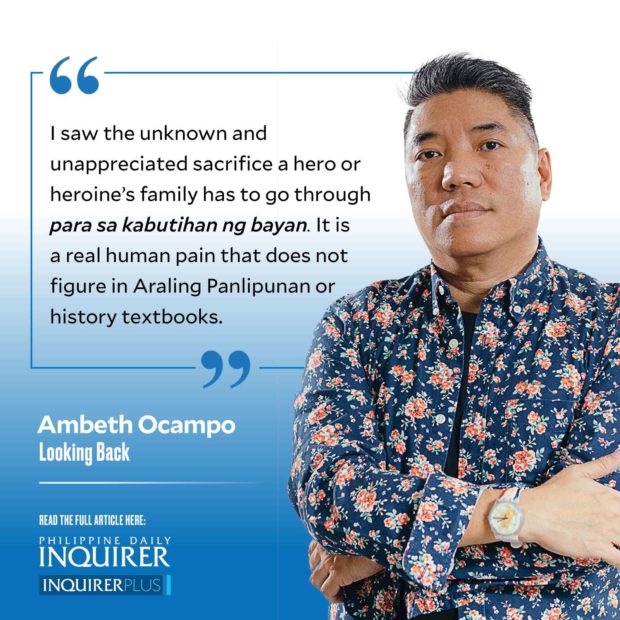
Jose Rizal had no children, but he was born, the seventh in a brood of eleven (7-11), so the descendants I interviewed in the 1980s were grandchildren of Rizal’s brother and sisters. At first, they were hard to track down from the phone book because none of them carried the surname Rizal, except a nephew, Leoncio Lopez (son of the hero’s favorite sister Narcisa), who styled himself in the Spanish fashion as Leoncio Lopez-Rizal. I met his daughters Asuncion, Carmen, and Natividad, who all lived on a sprawling compound on Lopez-Rizal Street, Mandaluyong, Rizal. One relative referred me to another, and yet another, leading me to know a Rizal of flesh and blood, rather than the bronze one I was introduced to on a boyhood trip to Luneta. While family lore gave me new insights, these were never taken at face value and always validated using Rizal’s own writings: diaries, letters, notes, essays, poems, and his novels.
Asuncion Lopez Bantug called me out when I wrote about Rizal’s detailed expenses noted down in his 1884 diary. She objected to my description of her Lolo Jose as kuripot (stingy), adding that the more apt adjective was “thrifty.” Some descendants recounted hiding their relation to Rizal when they were schoolchildren because teachers expected them to excel in class. This required more study than playtime. Maria Rizal’s grandson, Jose, became a Jesuit and served as president of Ateneo de Manila University, and it’s a pity I did not get to ask him about Rizal during the times he took me along to the Las Piñas Bamboo Organ Festival.
Another Jesuit descended from a National Hero was Fr. Vicente Marasigan, S.J., grandson of Marcelo H. del Pilar, the son of the hero’s daughter Anita. My excuse to visit him in Loyola House of Studies in 1989 was to have his book “Banahaw Guru” autographed and get an ambush interview. When I inquired about his lolo, I was taken aback by his reaction that was one of resentment rather than appreciation. He did not elaborate beyond stating that the hero abandoned his mother. Father Marasigan later sent me a copy of a speech he delivered in 1983 that summed up his reminiscences, that reads in part:
“The first flashback recalled April 1942. Radio listeners in Manila had just been stunned by the announcement of the surrender of Corregidor. There was an emotional scene between my father, my mother, and myself. My mother was objecting to something my father wanted to do ‘para sa kabutihan ng bayan’ [for the good of the country]. My mother answered. ‘Lagi na lang bang sa kabutihan ng bayan?’ and she choked in fits of hysterical sobbing. All her childhood years had been spent in emotional starvation due to the absence of Lolo Marcelo, far away in Barcelona sacrificing his family ‘para sa kabutihan ng bayan.’
“The second flashback is rather dim in memory. I was then two years old, in December 1920. I think I was on board a ship that had just docked at the pier, carrying the remains of Lolo Marcelo. All our relatives from Bulacan were present for the festive occasion. Some aunt or grandaunt was telling how proud and happy I must be. I did not understand what it meant to feel proud, but I knew I was very unhappy because I felt that my mother was unhappy. In the presence of that casket of bones, how could she forget the emotional wounds inflicted on her by her father ‘para sa kabutihan ng bayan.’”
Having read Del Pilar’s tearful letters to his wife, Tsanay, many of them written with homesickness and longing for his family while he was in Barcelona, I saw the unknown and unappreciated sacrifice a hero or heroine’s family has to go through para sa kabutihan ng bayan. It is a real human pain that does not figure in Araling Panlipunan or history textbooks. Love of country is real, it is not abstract, and often entails great personal sacrifice, not just to the hero or heroine but more so to their orphaned family and friends.
—————-
Comments are welcome at aocampo@ateneo.edu

